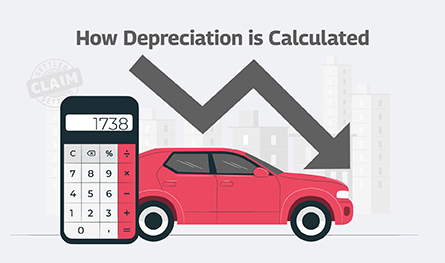A Quick Guide to Total Loss Car Insurance Settlement in India
.png)
Car accidents have been on the rise in India over the past few years. Car insurance helps to cover up the loss for a damaged car. If your vehicle is severely damaged, you can raise a car insurance claim under the total loss category. However, often vehicle owners don’t have adequate knowledge regarding the total loss in a car insurance claim. As a result, the insurance company offers them a lesser amount than the original losses incurred. In this post, we discuss what is total loss and how to claim car insurance in case of total loss.
.png)
- What is total loss car insurance settlement ?
- Constructive Total Loss
- Insured Declared Value and Total Loss
- When Does Total Loss Happen in Car Insurance?
- How To Claim Car Insurance?
- Documents Required for Car Insurance Claim
- How Many Times can Car Insurance be Claimed in a Year?
- Rate of Depreciation for Various Car Parts
- Car Accident Insurance Claim for the Full Value of your Car in Case of Total Loss
What is total loss car insurance settlement ?
When the repair and recovery cost of the car surpasses 75% of the Insured Declared Value (IDV) of the vehicle, it is considered to be total loss. Also, when the policyholder initiates a claim for serious damages or theft, the motor insurance company may declare the car as a total loss.
In this situation, the insurance provider compensates for the existing IDV of the vehicle minus the amount of mandatory excess. The company suggests that the owners take their vehicles to the recommended premise. The owner also needs to transfer the ownership of the damaged vehicle in the name of the insurance provider. Sometimes, the insurer also asks the owner to cancel the registration of the vehicle at the RTO office.
Constructive Total Loss
A constructive loss is considered when the repair or replacement cost of the car overpowers the present market value of the vehicle. An insurance company cannot agree for retrieval in this scenario; hence, it considers this as a total loss. For a constructive total loss, the car owner receives the current IDV of the car as reimbursement from the vehicle insurance provider.
Insured Declared Value and Total Loss
The Insured Declared Value of any car is calculated by deducting the valid depreciation from the ex-showroom price of the vehicle when it was insured. At the start of each policy period, the IDV of a vehicle is calculated. This value is the amount that an insurance company would pay the owner if the car cannot be repaired. This value diminishes with time.
IDV = The selling price of the vehicle by manufacturers + Total value of accessories – Depreciation according to the age of the vehicle
When Does Total Loss Happen in Car Insurance?
- Theft: If there is a burglary and you cannot locate the car, the insurance company would declare this as a total loss.
- Damage: if the damage repair cost of the car surpasses more than 75 percent of its cost, it is considered total loss. However, if the damage-retrieve cost is more than 100% of the market value of the car, it is called Constructive Total Loss.
How To Claim Car Insurance?
Let’s take a look at how to claim insurance for car damage in case of total loss:
- Whenever your car is damaged, intimate the insurance company immediately
- Provide all information to the adjuster sent by the insurer
- After evaluating the damage, the adjuster would decide whether the car would be sent for repair or it can be considered as total damage
- Once the car is declared as total loss, the adjuster evaluates the actual market value of the car
- The insurance company will reimburse the actual cash value of the totaled car
Documents Required for Car Insurance Claim
For claiming insurance for car damage in case of a total loss, you need to submit the following documents:
- Copy of RC (Registration Certificate), vehicle insurance policy, driving license, and FIR
- Duly-filled car insurance claim form
- Survey report by the adjuster
- Approximate repair cost of the vehicle
How Many Times can Car Insurance be Claimed in a Year?
There are no limitations to the number of claims that a car owner can raise to the insurance company.
Rate of Depreciation for Various Car Parts
| Car Parts | Rate of Depreciation |
| Paintwork | 50% |
| Rubber, plastic components, batteries, airbags, nylon, and tyres | 50% |
| Fiberglass parts | 30% |
| Glass components | No depreciation |
To calculate the IDV, depreciation is estimated according to the age of the vehicle
| Age of the vehicle | Rate of depreciation |
| New vehicle | 5% |
| Below 6 months | 5% |
| 6 months to 1 year | 15% |
| 1 year to 2 years | 20% |
| 2 years to 3 years | 30% |
| 3 years to 4 years | 40% |
| 4 years to 5 years | 50% |
| Above 5 years | The value is decided mutually between the car owner and the insurer |
Car Accident Insurance Claim for the Full Value of your Car in Case of Total Loss
In case of a total loss, if you want to receive the entire cost of replacement (not the depreciated value), you need to purchase Return-to-Invoice add-on insurance cover from the insurance company.
By purchasing this add-on facility, you will get the exact invoice value of your car (along with the registration expenses and all taxes). This is applicable only if your car is lost or damaged severely (beyond repair). Here, you will receive the actual amount that you paid initially as car insurance claim charges. Note that you’d need to purchase this add-on cover at the time of policy renewal, not after an accident/theft.
Although several companies offer various car insurance plans, it’s a good idea to check the car insurance claim settlement ratio before opting for a plan. To receive the claim amount from the insurer, you need to make a claim request by submitting all valid documents.
FAQs on #######
A total loss car insurance settlement is a type of insurance claim in which your car is deemed a total loss, meaning the cost of repairs exceeds the actual cash value (ACV) of your car. In this case, your insurance company will offer you a settlement amount based on the ACV of your car, minus any deductible or salvage value.
The ACV of your car is typically determined by an insurance adjuster, who takes into account factors such as the make and model of your car, its age, condition, and mileage. They may also consider factors such as the local market for similar cars and any recent upgrades or repairs you have made.
Certainly, if you believe the settlement amount provided by your insurance company is too low, you can negotiate it. To support your claim, you can submit documentation such as invoices for recent repairs or upgrades, or estimates from dealerships or mechanics. You may also choose to employ an independent appraiser to obtain an estimate of the worth of your vehicle. Keep in mind that your insurance company may also bargain with you, so be prepared to provide proof to back up your claims.

Author Bio
Paybima Team
Paybima is an Indian insurance aggregator on a mission to make insurance simple for people. Paybima is the Digital arm of the already established and trusted Mahindra Insurance Brokers Ltd., a reputed name in the insurance broking industry with 21 years of experience. Paybima promises you the easy-to-access online platform to buy insurance policies, and also extend their unrelented assistance with all your policy related queries and services.
Other Motor Insurance Products
Latest Post
.jpg)
Having a bike is not just about convenience, it’s a huge responsibility. Financial protection of your two-wheeler is important and the best way to ensure that is to have a bike insurance policy that will protect you in case of an accident, theft or a natural calamity. There are so many options when it comes to policies, making it difficult to know what’s best. This guide makes it easier to choose the best bike insurance policy that is suitable for you.


Non-linked, non-participating term plans are the ones that do not participate in the business and profit of the insurance company. These are fixed premium plans where the policyholder pays a fixed amount to ascertain a guaranteed sum as a return to be paid to the nominee in case of his/ her demise. Let’s learn more in this post.


Car depreciation implies the difference between the cost of a car at the time of buying the car and when you sell it. A car insurance claim amount is determined by the car depreciation rate. The car depreciation rate is the reduction in the value of your car over its lifespan caused by wear and tear.


Have you ever caught yourself lost in illusions about your daughter's future events, such as her university convocation and first day at work? Her university convocation. When she embarks upon her initial job after graduation will be the day.

.png)
Accidents can happen anywhere, anytime, by your own fault or another person. What’s important is to be prepared for such mishaps. This is where Own Damage Car Insurance comes in handy.






 Car Insurance
Car Insurance
